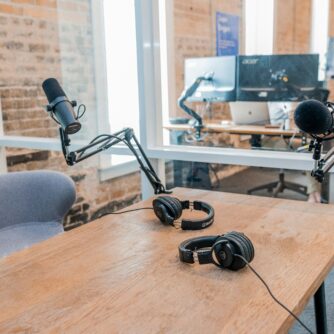You’re starting a podcast and you are wondering “What’s the best microphone for me?” Let’s take a look at three options that will fit just about any price point.

Audio-Technica AT2020
I’ve been using the AT2020 for about three years now. I couldn’t be happier with it. It’s probably not the most glamorus microphone, but it’s solid and gets the job done.
It’s a cardioid polar pattern condenser microphone. Dynamic microphones tend to be better for stage work, whereas the condenser is often better in the studio.
Generally speaking, the dynamic mic works better in recording loud sounds, whereas the condenser mic is better at the higher frequencies and more gentle sounds.
Since it’s a USB microphone, you’d need an interface for your computer. Naturally, I’m using the RODECaster Pro as an interface, and loving it as I mentioned previously.
The AT2020 is quite simply one of the best microphones you can buy at its level and price.
I don’t want this to be all about the AT2020, so let’s also take a look at another XLR option and a USB option.

Neumann TLM 103
My friend Darren Marlar has been using this microphone for several years for voice work and his great podcast Weird Darkness (Which you should definitely check out).
If you have the money (It’s about $1,000), it’s the best cardioid microphone available. It requires little post processing. You’re getting professional record-quality sound right out of the box. It has extremely low-self noise and distortion. It’s a very accurate microphone that sounds great in just about any mix situation.
I’m suggesting it as an option because if I ever got to the point where I needed an upgrade, that’s definitely the direction I’d go.

Shure MV7 USB Podcast Microphone
This one is actually just a little bit of a cheat because it’s both XLR and USB but that just means it can work for everyone!
My friend Ed Silha with the Radio Misfits Podcast Network played a role in getting this one ready for the masses.
By “masses” I mean literally anyone. It’s a mic that’s great for professional podcasters, streamers, and DIY musicians. Its houses a headphone jack alongside an XLR and microUSB output, which can all be used simultaneously.
They generally run about $250. So it’s a good middle ground between the bargain basement mic I traffic in and the ones that will set you back over $1,000.







